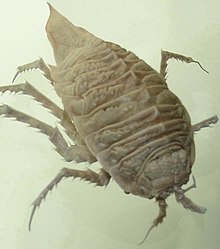Glyptonotus antarcticus
| Glyptonotus antarcticus | |
|---|---|
 |
|
| Scientific classification | |
| Kingdom: | Animalia |
| Phylum: | Arthropoda |
| Class: | Malacostraca |
| Order: | Isopoda |
| Suborder: | Valvifera |
| Family: | Chaetiliidae |
| Genus: | Glyptonotus |
| Species: | G. antarcticus |
| Binomial name | |
|
Glyptonotus antarcticus Eights, 1852 |
|
|
|
Glyptonotus antarcticus is a benthic marine isopod crustacean in the suborder Valvifera. It was first described by James Eights in 1852 and the type locality is the South Shetland Islands.
Glyptonotus antarcticus can grow to a maximum length of 9 cm (3.5 in) which is large for an isopod, most of which are between 5 and 15 mm (0.2 and 0.6 in) in length. It has two pairs of compound eyes, a large pair on the dorsal surface and a smaller pair on the ventral surface. It is thought that the latter are useful when the animal is swimming, which it does in an upside-down position. With the exception of the eyes, certain mouthparts and feet, the whole surface of the animal has minute cuticular outgrowths of feathery hairs and knobbly scales. It is thought that these may help to prevent attachment of Foraminifera and marine larval organisms on the body surface.
Glyptonotus antarcticus is native to the coasts of Antarctica, where it occurs in large numbers. It lives on the seabed at depths ranging from the intertidal zone down to about 580 m (1900 ft).
Glyptonotus antarcticus is a carnivore and scavenger and is often caught in baited traps on the seabed. It is an opportunistic predator with a mixed diet which includes a high proportion of echinoderms. That the available food supply may be fairly constant is shown by the fact that it breeds at any time of year.
Given its abundance and the fact that it is relatively easy to keep in aquaria, Glyptonotus antarcticus has become an important model organism used as a research object in ecological, biochemical and physiological studies. A 2005 genetic study suggested that Glyptonotus antarcticus may in fact represent several distinct species.
...
Wikipedia
